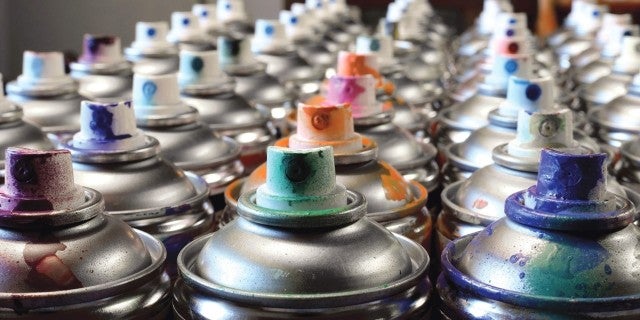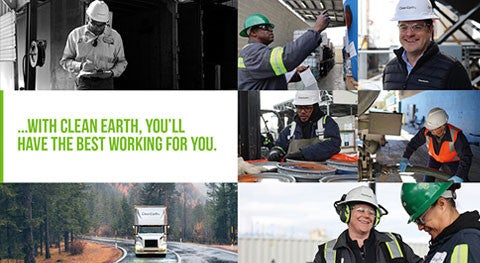The State of Aerosol Recycling Solutions & Regulatory Update Webinar Recap

On February 2, 2022, Howard Ray, Business Development Manager, and Wade Scheel, Director of Regulatory Affairs, held a webinar discussing the current state of Aerosol Recycling Solutions along with a regulatory update.
The webinar covered the following:
- Who Benefits from Aerosol Recycling & Reuse
- Why Choose Clean Earth for Aerosol Recycling and Reuse?
- What Does the Current Market Landscape Look Like?
- Regulatory Update from Wade Scheel
Who Benefits from Recycling & Reuse?
There are several routine factors that affect the recycling and reuse of aerosol products - the internal contents, propellant, size, and construction of the product. There is an ever- growing component of the aerosol manufacturing business where attachments are packaged in aerosol containers. This includes brushes, steel braids and rubber hoses. Some aerosol cans have lithium button batteries and lights, all of which affect the aerosol recycling process. There are circumstances where food product aerosols are governed by FDA regulations and the same goes with the DEA for pharmaceutical aerosols. Since February 2020, states have started adopting the EPA’s Universal Waste Rule, which affects both the receiving facilities and the transportation process. It’s important to keep in mind any local agencies, such as fire departments, are concerned about the flammability of the aerosol products being transported. Market conditions can also play a role, from the price, to foreign acceptance rules and freight costs.
Aerosols at Home – Just How Much Does the United States Consume?
Over 3 billion aerosol cans are produced annually in the United states alone. Five states account for 40% of the aerosol consumption – CA, TX, NY, FL and IL. Twenty states account for 48% of aerosol consumption.
Aerosols are grouped into six major categories:
- Household products
- Automotive lubricant and industrial
- Personal care (medical & cosmetics)
- Paints and finishes
- Food products and insect sprays
Who contributes to the recycling of the aerosols?
- 70% come from the households
- 20% come from industrial and commercial
- 10% come from aerosol can fillers and the manufacturers errors
When examining what, and how to process, different aerosols, Clean Earth groups them into two categories:
- Routinely accepted aerosols: paints, household cleaners, food-based, cosmetics, lubricants, bug sprays and insecticides. This includes the material that a consumer can buy at a department store, hardware store, lumber yard. This also includes chlorinated aerosols, adhesives, stucco aerosols, shaving cream and gels.
- Aerosols processed in limited quantities or sent to third parties. Examples include aerosols that carry the D003 waste code such as personal protective aerosols, pepper spray and mace, chemistry dependent insecticides, isocyanates, plastic aerosols, any aerosol smaller than 5 inches, inhalers, and powdered aerosols.
Chemistry Consideration
Clean Earth can accept all categories and classifications of aerosols, however, some categories/chemistries may require special handling, feed rates and require additional processing via incineration:
-
- D003 for chemistry = isocyanates
- Poison Inhalation Hazards
- Pepper Spray / Bear Spray / Mace
- Explosives
- Isocyanates
- U-Listed Chemistry
States still require aerosols that carry the D003 waste code to be put on the shipping papers because of the pressurization of the aerosol. If aerosols carry the D003 waste code it’s because they meet the EPA definition of reactive, which means the item is “capable of detonation or explosive reaction”. When Clean Earth processes these types of aerosols at our Morgantown, West Virginia facility, the state of West Virginia has allowed us to drop the D003 code once they are processed.
At Clean Earth, we are proud to say that we are able to recycle all components of the aerosol. This includes the consumer packaging (shrink-wrap, corrugated board, cardboard box), pallets and drums, hard plastic caps, exterior body (steel and aluminum), interior contents (through thermal recovery) and propellant.
The Overall Benefits of Aerosol Recycling
-
- Zero landfilling
- Reduction of carbon footprint
- Recycling millions of cans per year
- All component parts may be recycled
- Potential to return contents to manufacturer
- No long-term degradation exposure to the environment
- Cost-effective, customized solutions
- Fantastic statement on your “Environmental Social and Governance (ESG) Report”
How Does the Manufacturer Benefit from Aerosol Recycling and Reuse?
- Components back into commerce
- Reuse of material with BTU value
- Reuse of large project contents to be returned to manufacturer
- i.e. Truckload of product “product X” due to damage or blemish of can
- Follows preferred EPA hierarchy for management
- Nothing goes to landfill – “Green Process”
- Reduction in environmental liabilities
- No “Gray” market
- Protects your brand
- No additional liability
- Supports your corporation’s Sustainability Plan
How Does the Customer Benefit?
- Recycle vs disposal
- No long-term liabilities
- Potential reduction in regulatory paperwork with the increase of states adopting the EPA Universal Waste Rule
- Reduction in regulatory taxes (state dependent)
- Works with your sustainability goals
- Good community relations
- No “Gray” market
There’s still huge upside in this market, but our best estimate is that 10% of the aerosols in the United states are recycled, and of those 10%, they're virtually all steel or aluminum. When you recycle all component parts, you’re helping to remove media from landfill, eliminate groundwater soil contamination, and air emissions concerns.
Why Clean Earth?
There are only five major recyclers in the United States, but not all five process every type of aerosol. Clean Earth has been processing aerosols in Morgantown, West Virginia since 2013, and can accept aerosols in any package including a 5-gallon pail, up to a 55-gallon drum, a cubic yard box, or a super sack. We're very proud of our safety measures in Morgantown, which is a fully-permitted EPA RCRA Part-B facility. In addition, as aerosols come out of the hazardous waste market and become universal waste, invariably this material would be shipped as an aerosol that is that in fact is no longer an aerosol. Our facility is able to handle this material and assist the client in finding alternative homes for them. Additionally, we are audited by CHWMEG, a renowned third-party auditor, who granted our Morgantown facility approval to handle CERCLA waste. Clean Earth is proud to have properly trained staff who know the inherent dangers of the material
Regulatory Update
As part of our webinars such as this one, we also like to go beyond just sharing information around the marketplace and our capabilities. We also want to provide useful information around the regulatory landscape with regards to the Universal Waste Rule, and how itfits with the ability to manage aerosols now as universal waste. Clean Earth has been tracking the state-by-state adoption of the EPA's Universal Waste Aerosol Rule, which went into effect February 7th of 2020. This became automatically effective in a few states including Kentucky, Minnesota, New Jersey, North Carolina and Pennsylvania. There are also some states that had already adopted universal waste aerosols into their regulations. This includes California, Colorado, Minnesota, New Mexico, Ohio, Texas, and Utah. Each of these states had some form of universal waste aerosols written into their regulations already, but they're also going through the process of adopting the federal regulations. Currently, 28 states and Puerto Rico have adopted the universal waste regulations into their state regulations.
Highlights of the Aerosol Rule:
- Universal Waste Aerosols do not count towards hazardous waste generators status
- Empties and non-hazardous aerosols can be managed under new regulations
- Damaged or Leaking must be packaged in separate container, overpacked with absorbent, or immediately punctured and drained
- Same marking, labeling, accumulation time limits as existing UW rules
- ‘‘Universal Waste—Aerosol Can(s)’’ ‘‘Waste Aerosol Can(s)’’ or ‘‘Used Aerosol Can(s)”
- One Year Accumulation Limit
- Storage in structurally sound containers; prevent leaks; away from heat
- Can accumulate all types of aerosol products together – don’t need to separate by compatibility
- Puncturing and draining on-site is still acceptable as long as certain performance standards are met
- No notification requirements for Generators to use the new rule
Aerosol Transportation Challenges
- Many aerosols will still be a DOT hazmat – flammable or non-flammable compressed gas
- Aerosols may be shipped on a Bill of Lading (BOL) or Uniform Hazardous Waste Manifest (UHWM)
- Aerosols may need to be transported on a manifest if shipment is transported through states that have not adopted the Universal Waste rule
It’s important to consider the fact that not all states have adopted universal waste standards for aerosols. You are still able ship aerosols on a bill of lading or a universal hazardous waste manifest. Aerosols are still DOT hazardous material, so whichever of those methods you use to document the shipment, either in the form of a bill of lading or a hazardous waste manifest, it will still need to be shipped as a DOT hazardous material. You will need to use the proper shipping description and the proper UN number to ship that material. There is the need to ship on a manifest if that material is going to be transported through states that have not yet adopted the rule.
For more information on our services: Aerosol Services
To read our latest news and blogs: News
The information, content and materials provided in this “The State of Aerosol Recycling Solutions & Regulatory Update Webinar Recap” and in related materials (“Content”) does not, and is not intended to, constitute legal advice, nor is it prepared by lawyer or law firm or as the product of any attorney-client relationship. Content is provided "as is;" no representations are made that the content is error-free. Content is available for general informational purposes only and may not constitute the most current legal or other information. Recipients of the Content assume all responsibility and risk arising from its use and reliance upon the Contact and should contact an attorney to obtain advice before acting or refraining to act on the Content. All liability with respect to actions taken or not taken based on the Contents is hereby expressly disclaimed.


